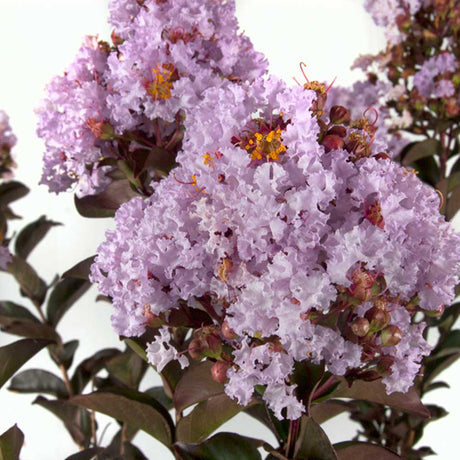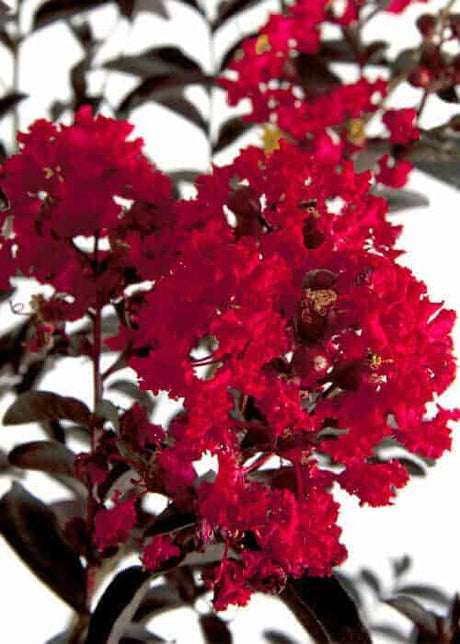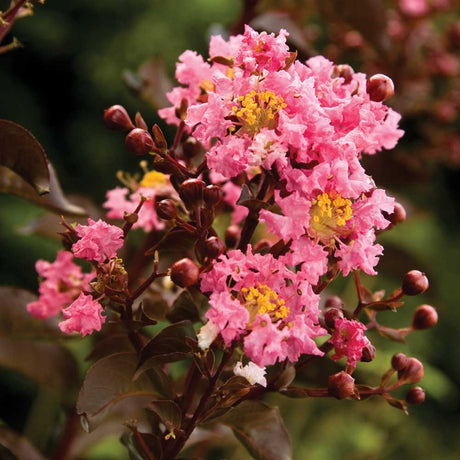Miami Crapemyrtle
Miami Crapemyrtle - 3 Gallon is backordered and will ship as soon as it is back in stock.
Couldn't load pickup availability
Description
Description
The Miami Crapemyrtle is an exquisite addition to any landscape that effortlessly infuses tropical allure with hardy resilience. This deciduous shrub or small tree is distinguished by its vibrant, magenta-pink blooms that emerge in generous clusters throughout the summer, creating an eye-catching display that evokes the lively spirit of its namesake city. During the Spring and Summer months, the foliage will be dark green and will change to lovely tones of orange throughout the Fall.
When fully grown, the Miami Crapemyrtle reaches a moderate height of about 15 to 20 feet with a spread of about 10 to 15 feet. This size makes it an ideal choice for both small and large gardens, as it provides significant presence without overwhelming the space.
Planting the Miami Crapemyrtle in your garden means more than just adding a plant; it's about bringing a piece of tropical vibrancy to your landscape. This tree is perfect for those looking to add a splash of color and a touch of the tropics to their outdoor space. Its resilience and low maintenance needs make it a practical choice for both novice and experienced gardeners.
Miami Crapemyrtle Care
The Miami Crapemyrtle has proven to remain both beautiful resilient in USDA zones 7-9, capable of enduring temperatures ranging from 0° to 30° F.
This variety of Crape Myrtle thrives in almost any moist, yet well-drained soil. To ensure optimal blooming and robust growth, it needs a minimum of 6 hours of direct sunlight each day to provide optimal opportunity for growth.
Watering and Pruning Miami Crapemyrtle Trees
Regular watering is essential, especially during the first growing season to establish a deep, extensive root system. Once established, they are relatively drought-tolerant, but it's important to maintain a consistent watering schedule during prolonged dry periods.
As for pruning, it should be done in late winter or early spring before new growth begins. Light pruning to shape the tree can also be performed, but it's crucial to avoid heavy pruning, as this can lead to excessive growth of shoots and reduce flowering. The goal is to maintain the natural form of the tree while promoting healthy growth and abundant blooms.
Mulching and Fertilizing Miami Crapemyrtle
Apply a 2-3 inch layer of mulch around the base of the Crapemyrtle. Be sure to leave some space around the trunk to prevent moisture buildup, which can lead to rot or fungal diseases.
Use a balanced, slow-release fertilizer that's formulated for flowering trees and shrubs. A formula with a higher phosphorus content can encourage better blooming. Apply fertilizer in early spring as new growth appears. Follow the manufacturer’s instructions regarding the amount and frequency.
- Mulching helps retain soil moisture, regulate soil temperature, and suppress weed growth. It also adds an aesthetic finish to the garden bed and contributes to the overall health of the Crapemyrtle.
- Use organic mulch like shredded bark, pine straw, or compost. These materials break down over time, adding nutrients to the soil.
- Apply a 2-3 inch layer of mulch around the base of the Crapemyrtle. Be sure to leave some space around the trunk to prevent moisture buildup, which can lead to rot or fungal diseases.
- Refresh the mulch layer annually or as needed, typically in the spring or fall.
*The Miami Crape myrtle is a deciduous/semi-evergreen plant that will go dormant during winter. Therefore, if you order this plant in the fall or winter, expect seasonal foliage decline (discoloration, spots, leaf drop) or the plant to arrive completely dormant.
Planting tips for Acid Loving Plants
Care & Use
Care & Use
Spacing Recommendations
Spacing Recommendations
-
Scientific Name
-
Hardiness Zone7, 8, 9
-
Sun ExposureFull Sun to Part Shade
-
Evergreen or DeciduousDeciduous
-
FeaturesAttracts Birds / Butterflies, Drought Tolerant, Fast Growth, Flowering, Heat Tolerant, Sun Loving
-
Feature ColorPink
-
UsesAccent, Container, Hedge, Specimen, Xeriscaping
-
Water NeedsMedium
-
Bloom SeasonSpring, Summer
Growing Zones : 7, 8, and 9












